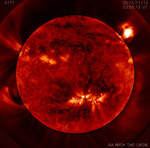Image List
-

This time-lapse movie shows two days of solar activity observed by the AIA instrument. Both the solar surface and dynamic inner corona are clearly visible in X-rays. Hot solar plasma streams outward in vast loops larger than Earth before plunging back onto the Sun's surface. Some of the loops expand and stretch bigger and bigger until they break, belching plasma outward. (Caution:740 MB file size)
NASA/LMSAL/SAO -

This photograph of the Sun, taken by the Atmospheric Imaging Assembly (AIA) instrument on NASA's Solar Dynamics Observatory, shows how image processing techniques developed at SAO can reveal the faint, inner corona. At the Sun's limb, prominences larger than the Earth arc into space. Bright active regions like the one on the Sun's face at lower center are often the source of huge eruptions known as coronal mass ejections.
NASA/LMSAL/SAO -

This zoomed-in image shows how the Sun's magnetic field shapes hot coronal plasma. Photos like this highlight the ever-changing connections between gas captured by the Sun's magnetic field and gas escaping into interplanetary space.
NASA/LMSAL/SAO